What’s Driving the Growth of EV Infrastructure? Buy EV Charging news for Key Updates
What’s Driving the Growth of EV Infrastructure? Buy EV Charging news for Key Updates
Blog Article
Leading EV Charging News: Secret Updates on Framework and Innovation

Recent Developments in Fast-Charging Innovation

In addition, developments in battery modern technology, including enhanced thermal management systems and higher power density batteries, complement fast-charging capacities. These developments alleviate the threat of battery degradation throughout quick charging, guaranteeing durability and efficiency for EV owners.
Furthermore, the assimilation of smart charging options is boosting customer experience, allowing real-time monitoring and dynamic pricing versions. EV Charging news. This flexibility enables vehicle drivers to optimize charging prices and times based upon grid demand
As automakers continue to spend in fast-charging networks, the cooperation between market stakeholders is critical. Partnerships between charging station companies and auto producers are leading the way for considerable insurance coverage, ultimately fostering a more robust EV environment. These advancements are critical in supporting the transition to sustainable transport.
Federal Government Campaigns for Billing Development
Federal government campaigns play a critical role in the expansion of electric vehicle (EV) charging framework, facilitating the transition to lasting transport. Numerous government and state programs are being carried out to improve charging ease of access, decrease the financial burden on customers, and advertise the fostering of electric cars.
Notably, the united state federal government has actually alloted substantial financing through the Infrastructure Financial Investment and Jobs Act, which allocates $7.5 billion for EV charging network development throughout the country. This funding is focused on releasing thousands of brand-new billing stations, particularly in underserved locations, consequently dealing with range anxiousness among potential EV customers.
Furthermore, various states are establishing regulations to improve the allowing process for billing station installations, which is crucial for increasing deployment. Motivations such as tax credit histories and rebates for both customers and companies are also being introduced to urge the setup of billing infrastructure.
In addition, public-private partnerships are increasingly coming to be a focus, leveraging exclusive financial investment to complement federal government funding. These efforts emphasize a collaborative technique crucial for developing a reliable and extensive EV billing network, inevitably contributing to a greener and even more sustainable future.
Ingenious Battery Solutions Enhancing Performance
Revolutionizing the landscape of electric automobile (EV) technology, innovative battery solutions are significantly boosting performance and performance. Breakthroughs in battery chemistry, especially with lithium-sulfur and solid-state batteries, are causing increased energy density, which allows for longer arrays and faster charging times. These new battery kinds have the prospective to surpass conventional lithium-ion batteries by using greater capacities while reducing weight, thus enhancing general automobile efficiency.
Furthermore, growths in battery monitoring systems (BMS) are enhancing power usage and prolonging battery life-span. Smart formulas keep an eye on battery health and wellness and performance, allowing real-time modifications to billing and releasing procedures. This not just improves the effectiveness of the battery however also makes certain a more sustainable and reliable power resource for EVs.
Moreover, the combination of reusing modern technologies is resolving the ecological effect of battery production and disposal. Innovations in second-life applications for EV batteries are promoting their use in power storage systems, adding to a round economic situation.
As these ingenious battery services continue to advance, they assure to change the EV market, making electric cars more appealing and accessible to a more comprehensive audience while supporting worldwide sustainability goals.

Collaboration Between Automakers and Charging Networks
Acknowledging the important demand for a durable billing framework, car manufacturers are significantly collaborating with charging network service providers to improve the EV ownership experience (EV Charging news). These partnerships intend to create a smooth billing ecological community that profits customers and sustains the change to electrical automobiles
Major automobile brands are joining forces with established billing networks to increase their charging station insurance coverage, making certain vehicle drivers have accessibility to trustworthy and practical charging options. For instance, partnerships with networks like ChargePoint why not look here and Electrify America permit car manufacturers to integrate charging solutions straight into their vehicles' navigation systems, guiding customers to the local stations and providing real-time schedule updates.
Moreover, these cooperations frequently cause the advancement of fast-charging technologies that substantially decrease the moment needed to reenergize an EV. By merging resources and competence, automakers and billing networks can introduce quicker, developing options that meet the expanding demand for electrical movement.
On top of that, joint efforts might also cause more standard charging procedures, which can reduce customer complication and promote wider EV fostering. In general, these tactical partnerships are pivotal in developing a reliable and user-friendly charging facilities that meets the requirements of an increasing electric vehicle market.
Difficulties Encountering EV Billing Infrastructure
As the electric automobile market remains to grow, numerous obstacles are surfacing that hinder the advancement of a thorough billing infrastructure. One of the key barriers is the insufficient number of charging stations, especially in rural and underserved urban areas. This space produces variety anxiousness amongst possible EV customers, the original source hindering them from making the button.
Additionally, the lack of standardization accountable innovation complicates the facilities landscape. Variations in plug types and charging speeds can create confusion for users and increase functional intricacies for billing network drivers. Moreover, the assimilation of billing stations into existing electrical grids poses significant obstacles. Lots of regions face capacity constraints, needing considerable investments in grid upgrades to accommodate raised need.
Another pushing problem is the high price related to the setup and upkeep of billing stations, which can be an obstacle for both personal businesses and public entities. Regulatory difficulties and zoning restrictions can postpone the deployment of charging framework, hindering progression in broadening crucial services. Resolving these challenges will certainly be crucial for promoting a durable EV community that sustains the transition to sustainable transport.
Conclusion
In final thought, the recurring innovations in EV charging technology, supported by considerable federal government campaigns and cutting-edge battery solutions, are important for the growth and performance of electrical lorry infrastructure. Collaborations between automakers and charging suppliers better boost terminal insurance coverage, resolving the expanding need for obtainable billing alternatives. Regardless of obstacles that linger within the EV billing landscape, these advancements symbolize a favorable trajectory towards a much more efficient and lasting electrical automobile environment.
Advancements get redirected here in billing facilities have actually led to the growth of ultra-fast chargers qualified of delivering up to 350 kW of power, dramatically minimizing charging times. Variations in plug kinds and charging speeds can develop confusion for individuals and enhance operational intricacies for billing network operators.In conclusion, the recurring innovations in EV billing technology, sustained by considerable government initiatives and cutting-edge battery options, are important for the expansion and performance of electric vehicle framework. Partnerships in between car manufacturers and charging carriers additionally enhance terminal protection, addressing the expanding demand for obtainable charging alternatives. In spite of obstacles that continue within the EV billing landscape, these advancements indicate a positive trajectory in the direction of a much more reliable and sustainable electrical vehicle environment.
Report this page